Creating A Digital Roadmap: The Ultimate Guide
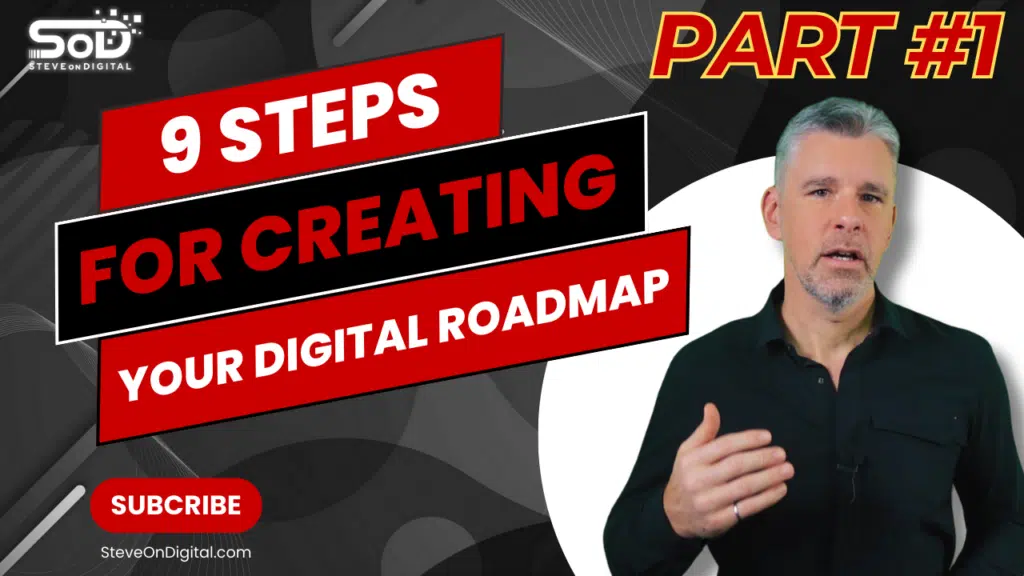
Creating a digital roadmap is crucial for business success and transformation. It acts like a GPS for your business, guiding you on where you are, where you need to go, and how to get there efficiently. To achieve this, it is essential to create a digital transformation roadmap, which involves assessing the organization’s digital maturity, defining objectives, prioritizing initiatives, integrating cutting-edge digital tools, and revolutionizing business practices. Without a digital roadmap, businesses often struggle with new digital technologies, leading to wasted resources and missed opportunities. I bring expertise in digital transformation, backed by an electrical engineering background, an MBA, and a master’s in Project Management. My goal is to help SMEs navigate the digital landscape with practical advice and insights. Understanding Digital Transformation Digital transformation refers to the integration of digital technologies into all areas of a business, fundamentally changing how you operate and deliver value to customers. It’s about more than just adopting new technologies; it’s about rethinking your business model and processes to stay competitive in today’s fast-paced digital world. A well-defined digital transformation roadmap is crucial in guiding the creation, execution, and importance of a strategic plan outlining the steps and milestones for integrating digital technologies into an organization’s operations. Digital transformation is not a one-size-fits-all solution. Each business needs to tailor its digital transformation strategy to meet its unique needs and goals. This involves understanding your current digital capabilities, identifying areas for improvement, and creating a plan to implement new digital technologies and processes. Why You Need A Digital Roadmap A digital roadmap is essential for guiding your business through the digital transformation process. It provides a clear, step-by-step plan for implementing digital technologies and processes, ensuring that all stakeholders are aligned and working towards the same goals. Digital initiatives play a crucial role in this process by implementing new digital strategies, technologies, and roadmaps to achieve more efficient business processes, digitally innovate, and create competitive advantages. Here are some key benefits of having a digital roadmap: Importance Of Effective Communication A focused digital strategy helps in aligning stakeholders and communicating the vision effectively. By clearly outlining the steps and goals of the digital transformation process, you can ensure that everyone in your organization understands the plan and their role in it. This is crucial for getting buy-in from all levels of the organization and ensuring that the transformation is successful. Viewing Digital Transformation As A Digital Transformation Journey Digital transformation is an ongoing process rather than a one-time project. It’s important to view it as a journey that involves continuous learning, adaptation, and improvement. A digital roadmap helps you stay focused on your long-term goals and make incremental progress towards achieving them. It allows you to break down the transformation process into manageable phases and track your progress along the way. Digital transformation roadmaps serve as the pathway from strategic vision to digital transformation goals, providing a clear, focused, and measurable plan for enacting transformation strategies. Supporting Decision-Making Knowing the reasons behind your digital transformation aids in making informed decisions during the process. A digital roadmap provides a framework for evaluating new technologies and processes, prioritizing projects, and allocating resources. It helps you make strategic decisions that align with your overall business goals and ensure that your digital transformation efforts are focused and effective. Assessing Your Starting Point Before you can create a digital roadmap, you need to assess your starting point. This involves evaluating your current digital capabilities, identifying areas for improvement, and setting realistic goals for your digital transformation journey. It is also crucial to review existing digital processes to identify any gaps or inefficiencies. Here are some steps to help you get started: Conducting A SWOT Analysis A SWOT analysis is a useful tool to find out your business’s good points and bad points, and to see what chances and risks are outside your business. By conducting a thorough SWOT analysis, you can gain a better understanding of your current digital capabilities and identify areas where you need to improve. Here are some tips for conducting a SWOT analysis: Category Description Strengths Strong leadership, skilled employees, advanced digital tools Weaknesses Outdated technologies, lack of digital skills, resistance to change Opportunities New technologies, market trends, customer demands Threats Competition, regulatory changes, economic instability Evaluating Current Digital Capabilities Assessing your existing digital tools and technologies is crucial for understanding your starting point in leveraging digital technology. This involves conducting a thorough review of your current digital processes, systems, and tools. Here are some tips for evaluating your current digital capabilities: By conducting a thorough assessment of your current digital capabilities, you can gain a better understanding of your starting point and identify areas for improvement. This will help you create a digital roadmap that is tailored to your unique needs and goals, and ensure the success of your digital transformation efforts. Identifying Your Highest Value Interaction The first step in creating a digital roadmap is identifying your highest value interaction. This is the process or interaction in your business that generates the most revenue. Focusing on this ensures that your digital transformation efforts have the maximum impact. Implementing an innovative digital strategy can further optimize these high-value interactions by leveraging new digital initiatives and technologies. Understanding Quote-To-Cash Processes The quote-to-cash process is the sequence of steps from providing a quote to receiving payment. This process is crucial because it directly affects your cash flow. Identifying and optimizing this process can significantly boost your business’s profitability. Here’s how you can approach it: Engaging With Your Team Involving your employees in the digital transformation process is essential. They can provide valuable insights and help ensure the success of your initiatives. It is crucial to drive change implementation and digital adoption across the entire organization, focusing on people-centric and cultural changes. Conducting Interviews And Workshops One effective way to engage with your team is by conducting interviews and workshops. These sessions allow you to gather insights about current processes and identify areas for improvement. Here
Digital Transformation: Challenges And Solutions | SteveOnDigital

Digital transformation challenges include legacy systems, skills gaps, and security concerns. Solutions involve strategic planning, skill development, and robust cybersecurity measures. I am a Digital Transformation Specialist with a background in electrical engineering, an MBA, and a master’s in Project Management. I assist small and medium-sized businesses (SMEs) in navigating the digital landscape, offering practical advice and insights from real-life scenarios. Introduction To Digital Transformation Digital transformation is more than a buzzword; it’s a vital process for every business to stay relevant. It means using digital technology in every part of your business. This changes how you run your business and how you provide value to customers. Leveraging digital solutions improves efficiency, productivity, and competitiveness. Embracing digital transformation is crucial to avoid falling behind. I’ve experienced the highs and lows of digital transformation, and while the journey is challenging, the rewards are immense. Overview Of Challenges And Solutions Every digital transformation journey comes with its set of hurdles. These challenges range from technical issues to cultural resistance within the organization. However, each challenge also presents an opportunity for growth and improvement. Here’s a brief overview of what we’ll tackle: Understanding Digital Transformation Definition And Scope Digital transformation means using new digital tools to change how a business works, its culture, and how it interacts with customers to keep up with changing business and market needs. This transformation transcends traditional roles like sales, marketing, and customer service. Instead, digital transformation begins and ends with how you think about and engage with customers. Key components include: Importance In The Digital Age In today’s digital age, businesses must transform to remain competitive. Customers expect seamless digital experiences, and companies that fail to deliver will quickly find themselves outpaced by more agile competitors. Benefits Of Successful Transformation: Key Challenges In Digital Transformation Legacy Systems Issues With Outdated Systems Dealing with legacy systems is one of the most significant digital transformation challenges. These systems are often outdated, inflexible, and incompatible with new digital technologies. As a result, they can hinder your efforts to modernize and streamline operations. I’ve worked with several small businesses where outdated systems caused major roadblocks, slowing down their entire digital transformation journey. Transitioning To Modern Systems The transition from legacy systems to modern digital solutions can be complex and costly. However, it’s a necessary step to stay competitive. I recommend a phased approach where you gradually replace old systems with new digital tools. For instance, start with the most critical systems and move towards less critical ones. This minimizes disruption and spreads the cost over time. Digital Skills Gap Identifying The Skill Shortage The digital skills gap is another significant challenge. Many small businesses struggle to find employees with the necessary digital expertise. In my experience, this gap often stems from rapid technological advancements outpacing the skills of the existing workforce. Solutions For Skill Development To overcome this, investing in training programs is crucial. Upskilling your current employees can be more cost-effective than hiring new staff. Additionally, consider partnering with local educational institutions to develop specialized training programs. I’ve seen businesses benefit greatly from internships and apprenticeships that bring fresh, tech-savvy talent into the organization. Change Management Resistance To Change Resistance to change is a natural human response, and it’s a common hurdle in digital transformation. Employees may fear job loss or feel overwhelmed by new technologies. This resistance can significantly slow down the transformation process. Strategies For Effective Change Management Effective change management is key. Communicate the benefits of digital transformation clearly and involve employees in the process. I’ve found that providing comprehensive training and continuous support helps in easing the transition. Leadership should actively champion the transformation, setting a positive example for the rest of the organization. Security Concerns Cybersecurity Risks Introducing new digital technologies can expose your business to cybersecurity risks. Cyberattacks can result in data breaches, financial loss, and damage to your reputation. Implementing Security Measures Implementing robust security measures is essential. You can take steps like doing regular security checks, teaching employees about cybersecurity best practices, and spending money on better cybersecurity tools. In my experience, outsourcing cybersecurity to experts can provide an additional layer of protection and peace of mind. Cost And Budget Constraints Financial Challenges Digital transformation can be expensive, and managing these costs is a significant challenge, especially for small businesses. Cost-Effective Solutions Careful financial planning and prioritizing digital investments can help manage costs. Look for scalable and flexible digital solutions that grow with your business. Cloud-based services, for example, often offer affordable, pay-as-you-go pricing models. This approach allows you to spread costs over time, making it easier to budget for your transformation efforts. Integration Of New Technologies Compatibility Issues Integrating new digital technologies with existing systems can be a daunting task. Compatibility issues can lead to disruptions and inefficiencies. Solutions For Seamless Integration Start small and scale gradually. Test new technologies in a controlled environment before full implementation. This approach minimizes risk and ensures compatibility. Working with experienced digital transformation consultants can also facilitate a smoother integration process. Solutions For Overcoming Digital Transformation Challenges Developing A Digital Transformation Strategy Key Elements Of A Strategy A well-defined digital transformation strategy is essential. This strategy should outline your goals, the technologies you plan to implement, and the steps you’ll take to achieve your objectives. Steps To Develop An Effective Strategy Step Description Assess Current State Evaluate existing systems, processes, and technologies. Define Goals Set clear, measurable objectives for the transformation. Plan Technology Investments Identify necessary digital tools and technologies. Develop a Roadmap Create a timeline with milestones and checkpoints. Investing In Digital Skills Training Programs Investing in training programs for your current employees is crucial. Focus on developing skills that are essential for your digital transformation. Hiring Specialized Skills In some cases, hiring specialists may be necessary. Look for candidates with expertise in the technologies and processes you plan to implement. I’ve found that blending in-house training with external hiring creates a balanced approach to building a digitally skilled workforce. Enhancing Cybersecurity
Make Better Business Decisions: The Data-Information-Knowledge Cycle
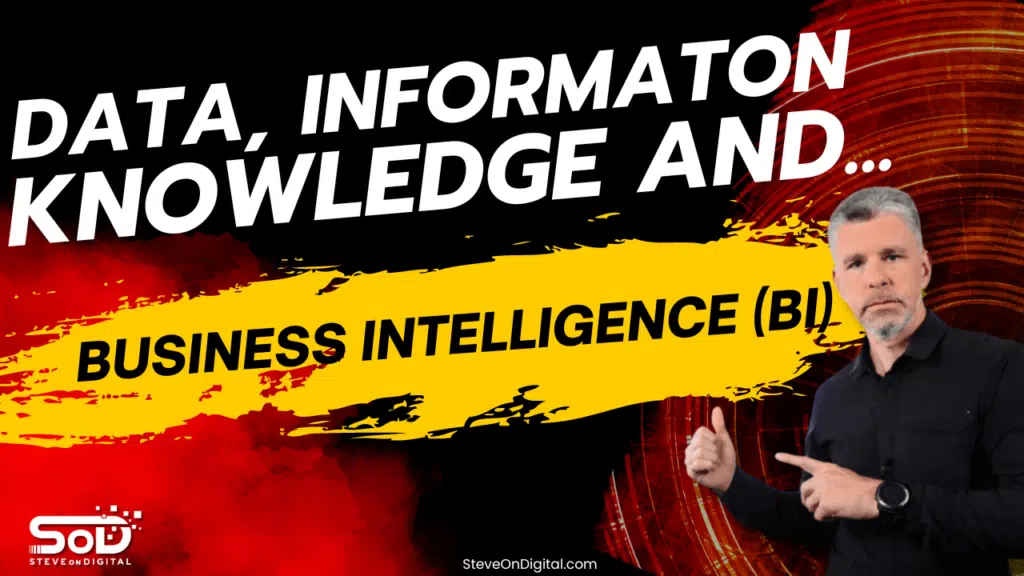
The Data-Information-Knowledge Cycle (DIKW) helps transform raw data into valuable insights. It starts with data, turns it into information, gains knowledge from it, and finally, applies wisdom for better decisions. As the Digital Transformation Specialist, I assist small and medium-sized businesses (SMEs) with practical advice and insights drawn from real-life scenarios. My background includes electrical engineering, an MBA, and a master’s in Project Management. I aim to help 1,000,000 business owners and IT directors navigate the digital landscape. Overview Of The DIKW Cycle The DIKW cycle is a hierarchical model that describes how raw data evolves into valuable wisdom. It’s a step-by-step process that starts with data and moves through information and knowledge before finally arriving at wisdom. This cycle is crucial for business decision-making because it helps us understand the context and meaning behind the raw data we collect. Significance In Business Intelligence The DIKW cycle is the backbone of business intelligence. By following this cycle, we can turn raw data into actionable insights. This not only reduces risks but also helps in making more informed decisions. For example, understanding customer loyalty trends from data can guide us in creating more effective marketing strategies. Understanding The DIKW Cycle Data: The Foundation Data is the starting point of the DIKW cycle. It consists of raw facts and figures without context. In a business context, data can include anything from sales numbers to website traffic statistics. For example, the number of visitors to a website or the number of products sold in a day are pieces of raw data. Types Of Data Data can be broadly categorized into structured and unstructured data. Structured data is organized and easily searchable, like databases and spreadsheets. Unstructured data, on the other hand, includes things like social media posts and emails, which don’t have a pre-defined format. Type of Data Description Examples Structured Data Organized data with a fixed format Databases, Spreadsheets Unstructured Data Unorganized data without a predefined format Social Media Posts, Emails Transforming Data Into Information Data becomes information when it is processed and organized in a way that makes it meaningful. This involves categorizing, labeling, and interpreting data to reveal patterns and trends. For instance, organizing sales data by region can show which areas have the highest sales. Information Overload One of the challenges we face is information overload. With so much data available, it can be difficult to distinguish what’s important. To manage this, we need strategies like data filtering and prioritization to focus on the most relevant information. From Information To Knowledge Knowledge is gained by analyzing and understanding the information we have. This step involves looking at information in context and applying experience and expertise to interpret it. For example, knowing that sales are highest in a specific region during certain months can help plan inventory and marketing efforts. Explicit Vs. Tacit Knowledge Explicit knowledge is easily communicated and shared, like documented processes and procedures. Tacit knowledge, on the other hand, is more intuitive and harder to transfer, such as personal insights and experiences. Both types are valuable in business decision-making. Wisdom: The Pinnacle Wisdom is the final stage of the DIKW cycle. It involves making informed decisions based on the knowledge gained. Wisdom combines understanding with foresight, allowing us to predict outcomes and make strategic decisions. Business Intelligence And Wisdom Business intelligence is essentially applied wisdom. It’s about using the insights gained from the DIKW cycle to make proactive decisions. For example, using knowledge about customer preferences to tailor marketing campaigns can lead to increased sales and customer loyalty. The DIKW Hierarchy In Practice Real-World Applications When I first started applying the Data-Information-Knowledge-Wisdom (DIKW) cycle in my business, the transformation was remarkable. The DIKW cycle isn’t just a theoretical concept; it’s a practical tool that can revolutionize the way we operate. Let me share some examples from my own experience and other business scenarios. One real-world application of the DIKW cycle is in managing customer feedback. Initially, customer comments and reviews were just raw data. By categorizing these comments into positive and negative feedback, I turned data into information. Analyzing this information revealed patterns, such as common complaints about a specific product feature. This knowledge allowed me to make informed decisions to improve that feature, ultimately leading to increased customer satisfaction. Case Study: Marketing Strategy Implementing the DIKW cycle in marketing was a game-changer for me. Here’s a detailed example of how it can be used to create a targeted marketing campaign. Role In Customer Loyalty And Employee Satisfaction The DIKW cycle is also instrumental in enhancing customer loyalty and employee satisfaction. Here’s how I’ve seen it work: Benefits Of Implementing The DIKW Cycle Enhanced Decision-Making One of the most significant benefits of the DIKW cycle is its impact on decision-making. By following the DIKW process, I ensure that my decisions are based on solid data and informed analysis. This leads to more accurate and effective business strategies. For example, using historical sales data to forecast future demand helps in making better inventory decisions. Risk Management Implementing the DIKW cycle also plays a crucial role in risk management. By analyzing data and information, I can identify potential risks and develop strategies to mitigate them. For instance, monitoring market trends and competitor actions allows me to anticipate changes and adapt my strategies accordingly, reducing the risk of business losses. Improved Business Intelligence The DIKW cycle enhances business intelligence by providing deeper insights into various aspects of the business. By turning raw data into actionable wisdom, I can make more informed decisions that drive business growth. For example, understanding customer behavior patterns helps in tailoring marketing efforts to meet their needs more effectively. Benefit Description Enhanced Decision-Making Provides a structured approach to make informed decisions based on solid data Risk Management Identifies potential risks and develops strategies to mitigate them Improved Business Intelligence Offers deeper insights into various business aspects, aiding in strategic planning Tools And Technologies For DIKW Data Collection Tools Effective data collection is the foundation
People-Process-Technology Analysis: People At The Core
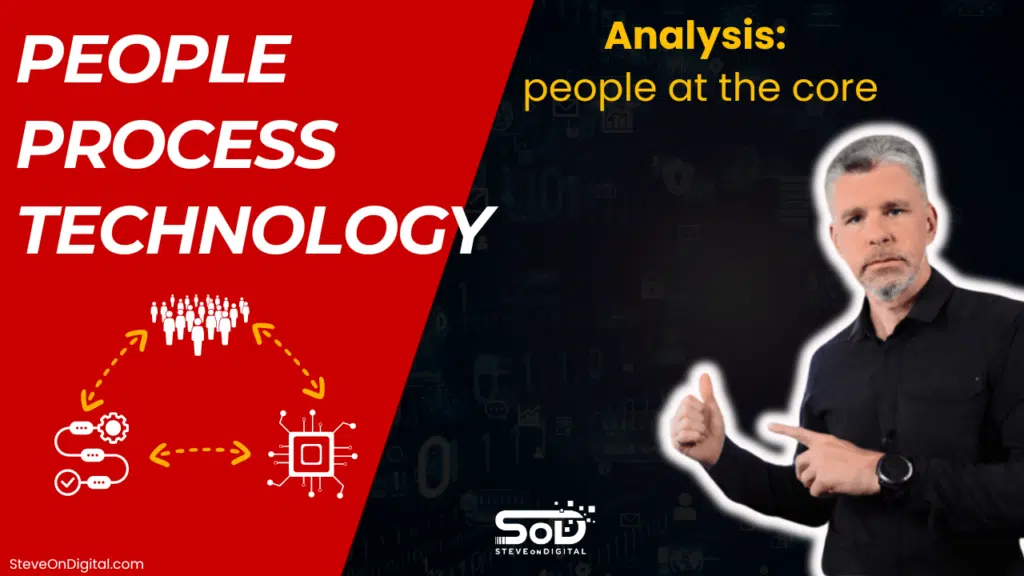
People-Process-Technology (PPT) analysis is crucial for optimizing business operations. It ensures that people, processes, and technology work together seamlessly, enhancing efficiency and success. As a Digital Transformation Specialist with expertise in helping small and medium-sized businesses, I leverage my background in electrical engineering, an MBA, and a master’s in Project Management to guide businesses through the digital landscape. My goal is to assist 1,000,000 business owners and IT directors with practical advice and insights from real-life scenarios. In this blog, I will break down the PPT framework and explain how to use it to transform your business effectively. Understanding The People-Process-Technology Framework The People-Process-Technology framework serves as a strategic approach to managing business operations. This framework helps in identifying the strengths and weaknesses within an organization and provides a roadmap for improvements. People Component The people component focuses on the human resources within an organization. This includes employees’ skills, experience, and engagement levels. It’s crucial to understand that people are not just resources but the core drivers of innovation and productivity. Proper training and continuous development are essential to keep the workforce competent and motivated. For example, when I implemented a new customer relationship management (CRM) system in my business, I ensured that every team member received adequate training. This not only improved their proficiency but also boosted their confidence and job satisfaction. Process Component Processes are the systematic steps and procedures that guide how tasks are performed within an organization. Well-defined processes are critical for achieving consistency, efficiency, and quality. They help in streamlining workflows and eliminating bottlenecks. During one of my projects, I realized that our existing processes were causing delays in project delivery. By conducting a thorough analysis and implementing process improvements, we were able to reduce turnaround times and enhance overall productivity. Technology Component Technology acts as the enabler within the PPT framework. It provides the tools and platforms necessary for automating tasks, improving communication, and enhancing productivity. The rapid pace of technological advancements means that businesses must continuously adapt and integrate new technologies to stay competitive. In my experience, adopting cloud computing solutions significantly improved our data management and collaboration capabilities, leading to better decision-making and faster project execution. The Interplay Between People, Process, And Technology The true power of the PPT framework lies in the interplay between its three components. People use technology to perform processes. In turn, technology can streamline processes and make them more efficient, freeing up people to focus on more strategic tasks. This cyclical relationship creates a dynamic environment where continuous improvement is possible. For instance, by integrating a new project management tool, I was able to automate routine tasks, allowing my team to concentrate on more critical aspects of our projects, ultimately achieving better results. The Core Principles Of People-Process-Technology Understanding the core principles of People-Process-Technology (PPT) is essential for any business striving for success in today’s digital age. This framework helps in achieving organizational efficiency by ensuring that all three components work together harmoniously. Let’s dive into each component of the PPT framework and explore its significance. People Component The people component is the heart of the PPT framework. It’s all about the individuals who work within the organization. Their skills, engagement, and adaptability play a crucial role in driving business success. Skills And Training Proper training is vital for effective technology adoption. When I first introduced a new customer relationship management (CRM) system in my business, I realized that training my team was the key to its success. Without adequate training, even the best technology can become a burden rather than a benefit. Investing in continuous skill development ensures that employees stay up-to-date with the latest technological advancements and can utilize them effectively. Skill Current Proficiency Level Required Proficiency Level Training Needed Customer Service Intermediate Advanced Advanced Customer Service Workshop Project Management Beginner Intermediate Project Management Basics Course Data Analysis Intermediate Advanced Advanced Data Analysis Techniques Employee Engagement Maintaining high levels of employee engagement during technological changes is another crucial aspect. Engaged employees are more productive and motivated. One strategy I found effective was involving my team in the decision-making process when introducing new technologies. This not only made them feel valued but also reduced resistance to change. According to a Gallup report, businesses with highly engaged employees see a 21% increase in profitability. Process Component Processes are the structured methods and practices that guide how work is done within an organization. They are the backbone of operational efficiency and quality. Process Improvement Identifying and improving existing processes is essential for increasing efficiency. In my experience, conducting regular process audits helps in pinpointing inefficiencies and areas for improvement. For example, by streamlining our project management process, we were able to reduce project delivery times by 20%. Continuous improvement should be a core principle in every business. Process KPI Current Value Target Value Improvement Plan Order Processing Cycle Time 48 hours 24 hours Implement automation software Customer Support Response First Response Time 6 hours 1 hour Introduce AI-based support system Inventory Management Stock Accuracy 85% 95% Deploy RFID technology Process Deployment Deploying new processes involves careful planning and integration with existing ones. When I implemented a new project management tool, it was crucial to ensure that it aligned with our current workflows. This required a detailed analysis of our existing processes and strategic planning to integrate the new tool seamlessly. This step is critical to avoid disruptions and ensure smooth transitions. Technology Component The technology component of the PPT framework focuses on the tools and platforms that enable and enhance business operations. It includes everything from software applications to hardware infrastructure. New Technologies Evaluating and implementing new technologies effectively is crucial for staying competitive. I always start by assessing the specific needs of my business and then researching technologies that can address those needs. For instance, adopting cloud computing solutions significantly improved our data management and collaboration capabilities. It’s important to stay informed about the latest technological advancements and choose solutions that offer the most value.
Creating A Coordinated Strategy Throughout Your Digital Journey
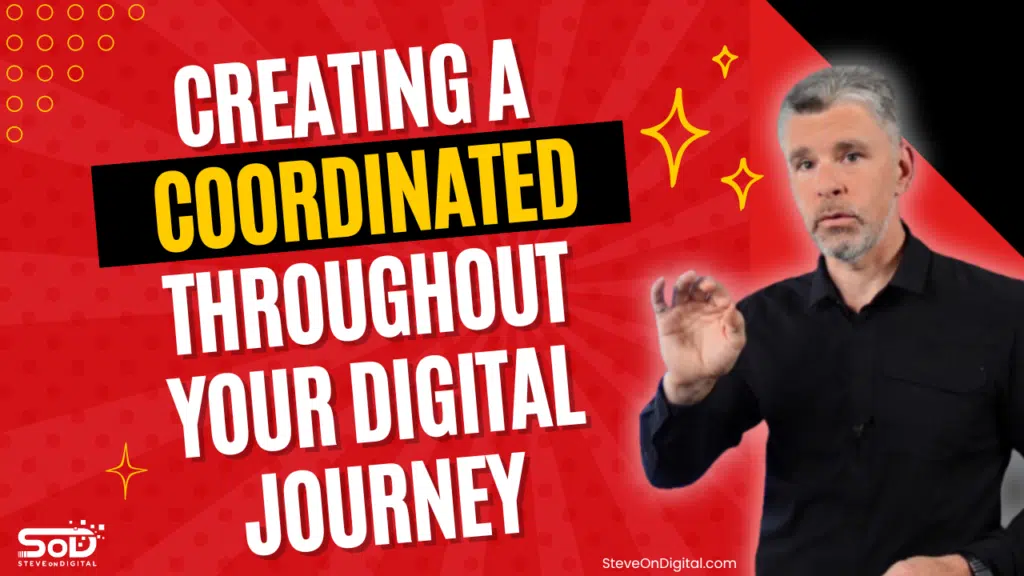
Creating a coordinated strategy helps businesses streamline operations, align goals, and save time and resources, ultimately driving success. I, Steve Johnston, am a Digital Transformation Specialist with expertise in helping small and medium-sized businesses navigate the digital landscape. My background in electrical engineering, an MBA, and a master’s in Project Management allow me to offer practical advice and insights to SMEs. Understanding Coordinated Strategy To create a coordinated strategy, you need to understand what it entails and why it is vital for your business. Definition And Importance A coordinated strategy aligns various business functions to work towards common goals and objectives. It involves strategic planning, project management, and continuous monitoring. This strategy ensures that all departments are on the same page, reducing conflicts and improving efficiency. For example, in my experience, when all teams understand the common goal, it reduces duplicated efforts and wasted time. Key Benefits A well-executed coordinated strategy brings numerous benefits: Steps To Create A Coordinated Strategy Here are the detailed steps I follow to create a coordinated strategy. Identifying Business Goals And Objectives Start by clearly defining your business goals and objectives. This step is critical as it lays the foundation for your strategy. Make sure these goals are specific, measurable, achievable, relevant, and time-bound (SMART). Conducting A Strategic Planning Process The strategic planning process involves evaluating your current position, identifying opportunities, and setting a clear path forward. Here’s how I usually approach this: Step Description Assess Current Situation Analyze strengths, weaknesses, opportunities, and threats (SWOT analysis) Set Strategic Objectives Define objectives based on SWOT analysis Develop Action Plans Outline detailed action plans to achieve objectives Involving Key Stakeholders Involving key stakeholders in the planning process is essential. This includes team members from various departments, as their input can provide valuable insights. In my practice, I always ensure that all relevant parties are engaged in the planning process to avoid silos and foster collaboration. Essential Components Of A Coordinated Strategy A coordinated strategy comprises several critical components. Clear Communication Channels Effective communication is the backbone of a coordinated strategy. Establishing clear communication channels ensures that everyone is informed and aligned with the strategic goals. Regular meetings and updates are essential to keep the team on track. Resource Allocation Efficient resource allocation is crucial for achieving your strategic goals. This involves distributing sufficient resources, such as time, money, and personnel, to where they are most needed. I always emphasize the importance of proper resource allocation to avoid bottlenecks and delays. Horizontal Coordination Horizontal coordination refers to the collaboration across different departments. It’s essential to break down departmental barriers and promote teamwork. For instance, I’ve seen how effective horizontal coordination can lead to innovative solutions and timely completion of projects. Role Of Project Management In Strategy Project management plays a crucial role in integrating and supporting a coordinated strategy. It ensures that all strategic initiatives are executed efficiently and effectively, leading to project success and the achievement of business goals. I’ve witnessed how robust project management practices can transform ideas into actionable plans, driving progress and innovation. Project Manager’s Role A project manager is at the heart of strategy execution. Their responsibilities include: A good project manager is like the captain of a ship, steering the team through the strategic planning process to reach the desired outcomes. Tracking Project Progress Monitoring and tracking project progress is essential for strategy execution. Here are some methods I find effective: By keeping a close eye on project progress, you can make informed decisions and adjustments to stay on course. Utilizing Data Analysis Tools Data analysis tools are indispensable for creating and executing a coordinated strategy. They provide valuable insights that inform decision-making and strategy refinement. Types Of Data Analysis Tools There are various data analysis tools available, each serving different purposes: Tool Type Examples Purpose Business Intelligence Tableau, Power BI Visualize data and identify trends Statistical Analysis SPSS, SAS Conduct in-depth statistical analysis Predictive Analytics RapidMiner, KNIME Forecast future trends and outcomes Each tool has its strengths and can be used to gain different types of insights. Benefits Of Data Analysis Data analysis offers several benefits: I’ve seen how leveraging data analysis tools can turn raw data into actionable insights, driving better strategy execution and project success. Setting Key Performance Indicators (KPIs) Establishing KPIs is essential to measure the success of your coordinated strategy. They serve as benchmarks to track progress and evaluate performance. Identifying Relevant KPIs When selecting KPIs, consider the following criteria: KPI Description Example Target Customer Satisfaction Score Measures customer satisfaction with products/services Achieve an average score of 8/10 Sales Growth Rate Measures the rate of increase in sales over time 10% growth per quarter Employee Productivity Measures the output of employees Complete 5 projects per month For example, if improving customer satisfaction is a goal, a relevant KPI might be the Net Promoter Score (NPS). Monitoring And Adjusting Kpis Monitoring KPIs is a continuous process. Here’s how I do it: By actively monitoring and adjusting KPIs, you can keep your strategy on track and achieve your business objectives. Mitigation Strategies For Potential Issues Creating a coordinated strategy isn’t without its challenges. It’s important to anticipate potential issues and have mitigation strategies in place to address them effectively. I’ve encountered various obstacles in my career, and having a plan to tackle them is crucial for project success. Common Challenges Here are some typical issues that might arise during strategy implementation: Solutions And Best Practices To overcome these challenges, I’ve found the following solutions and best practices to be effective: Common Challenges Solutions and Best Practices Communication Breakdowns Establish clear communication channels and encourage open dialogue Resource Constraints Prioritize resource allocation to critical tasks and ensure sufficient resources Resistance to Change Implement change management strategies, including training and support Lack of Clear Goals Define clear, measurable goals and objectives Importance Of Regular Meetings Regular meetings play a vital role in ensuring strategy alignment and progress. They provide an opportunity for team members to discuss updates, address potential
Top Benefits Of Creating A Digital Roadmap For Your Business
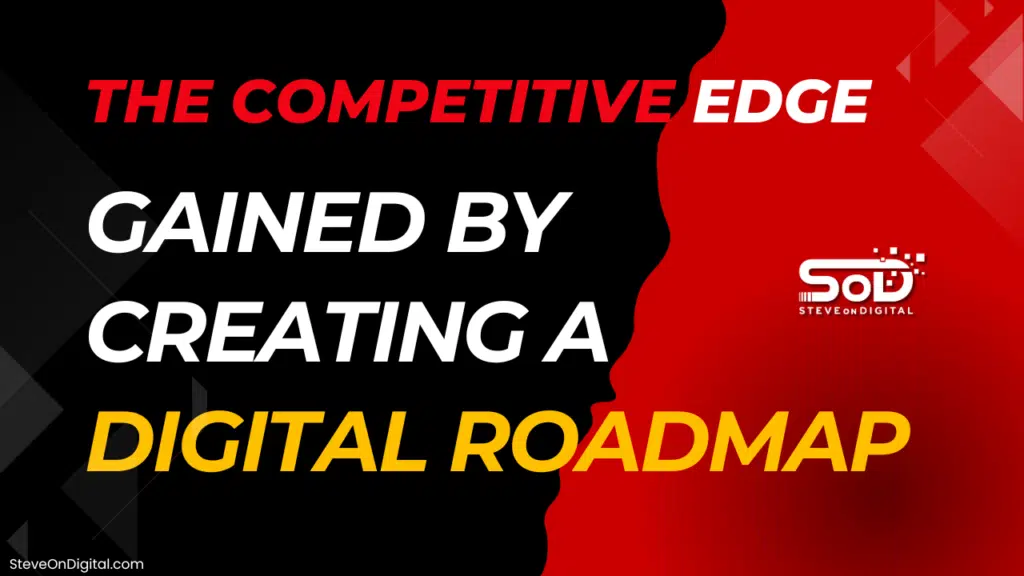
Creating a digital roadmap offers significant benefits for businesses today. It provides a strategic plan for implementing digital tools and technologies, ensuring alignment with business goals. A well-structured digital roadmap improves operational efficiency, enhances communication, and boosts technology adoption rates, making your business more competitive and efficient. As a Digital Transformation Specialist, I bring extensive expertise tailored for small and medium-sized businesses (SMEs). With a background in electrical engineering, an MBA, and a master’s in Project Management, I aim to help 1,000,000 business owners navigate the digital landscape. My experiences and practical insights from real-life scenarios are geared toward SMEs, reflecting my commitment to continuous learning and entrepreneurial support. Understanding The Benefits Of Creating A Digital Roadmap A comprehensive technology roadmap is a comprehensive plan that outlines how a business will implement digital tools and technologies. It’s crucial in the digital transformation process, guiding companies through various phases of adoption and integration. Definition Of A Digital Roadmap A digital transformation roadmap is a strategic plan that details how digital tools and technologies will be integrated into a business. This roadmap is vital for digital transformation, ensuring a structured approach to adopting new technologies. Components Of A Digital Roadmap The key components of a digital roadmap include ecosystem mapping and a detailed timeline. These elements help businesses visualize how various software and technologies interact and when they will be implemented. Component Description Software Ecosystem Shows how different software programs and tools work together. Implementation Timeline Details when each technological solution will be introduced and in what order. Key Benefits Of Creating A Digital Roadmap A well-structured digital roadmap offers numerous benefits, helping businesses streamline operations, improve communication, and increase technology adoption rates. Digital strategies empower companies to protect themselves from culture shifts and digital threats. Benefit Description Improved Operational Efficiency Streamlines processes, reduces redundancies, and leads to time and cost savings. Enhanced Communication Facilitates better team communication and collaboration. Higher Technology Adoption Rates Engages employees in the planning stages, leading to a smoother transition to new technologies. Improved Operational Efficiency A focused digital strategy helps companies identify digitalization opportunities and guides them on how to apply these to their current business models and offerings. Digital roadmaps streamline business processes, making operations more efficient and reducing redundancies. This leads to significant time and cost savings. Enhanced Communication A digital roadmap facilitates better communication within teams. It provides a clear visual representation of how and when new tools will be introduced, ensuring everyone is on the same page. Higher Technology Adoption Rates Involving team members in the planning process increases the adoption rates of new technologies. When employees understand and contribute to the roadmap, they are more likely to embrace new tools. Creating a digital roadmap isn’t just a plan; it’s a strategic move towards achieving digital success. From improving operational efficiency to enhancing communication and boosting technology adoption rates, the benefits are substantial. As someone who has seen the transformative power of a well-executed digital roadmap, I can attest to its value in driving business growth and staying competitive in today’s digital landscape. An innovative digital strategy can further enhance these efforts by implementing new digital initiatives and technologies to unlock new opportunities and create competitive advantages. The Role Of Digital Roadmaps In Digital Transformation Aligning With Business Strategy A digital roadmap aligns digital initiatives with overall business strategies. It’s not just about adopting new technologies; it’s about integrating them in a way that supports your business goals. I’ve seen firsthand how a well-aligned digital roadmap can transform a business, making it more competitive and efficient. Supporting Digital Transformation Journeys Digital roadmaps support continuous digital transformation. They provide a structured approach that allows businesses to evolve with technology. This continuous improvement is key to staying competitive in today’s market. Steps To Create An Effective Digital Roadmap Step Description Assessing Current Digital Capabilities Evaluate existing digital tools and technologies to understand current capabilities. Identifying Business Objectives Define clear business objectives that align with overall business goals. Developing the Roadmap Map out strategies and create an implementation plan. Implementing the Roadmap Execute the plan, monitor progress, and make necessary adjustments. Assessing Current Digital Capabilities The first step in creating a digital roadmap is to assess your current digital capabilities. This involves evaluating existing digital tools and technologies to understand where you stand and what you need. Identifying Business Objectives Next, define clear business objectives that the digital roadmap will support. These objectives should be aligned with your overall business goals to ensure that the digital strategy drives business success. Developing The Roadmap Once you have a clear understanding of your current capabilities and objectives, it’s time to develop a successful digital transformation roadmap. This involves mapping out strategies and creating an implementation plan. Implementing The Roadmap The final step is to implement the digital roadmap. This involves executing the plan, monitoring progress, and making necessary adjustments. Tools And Technologies For Digital Roadmaps Tool/Technology Description Digital Adoption Platforms Facilitates digital adoption and ensures employees are adequately trained. Project Management Tools Tools like Trello or Asana that help manage projects efficiently. Collaboration Software Tools like Slack or Microsoft Teams that enhance team collaboration. Emerging Technologies AI, Machine Learning, IoT, and Blockchain offer new opportunities for innovation and efficiency. Digital Adoption Platforms Digital adoption platforms are crucial for facilitating digital transformation. They help businesses integrate new technologies smoothly and ensure that employees are adequately trained. Software And Applications There are several essential software applications that can support the creation and maintenance of a digital roadmap. These tools help in project management and team collaboration. A well-defined technology strategy framework can provide a clear roadmap for technology initiatives, guiding investment decisions, and helping organizations deploy technology with a plan for the future. Emerging Technologies Emerging technologies like AI, machine learning, IoT, and blockchain are transforming digital roadmaps. These technologies offer new opportunities for innovation and efficiency. Challenges In Creating A Digital Roadmap Challenge Description Resistance to Change Employees may feel threatened by new technologies or processes.
SoD Is Launching Soon !!!

Making Digital Transformation Easy! Videos and Blogs are coming !!! I want to share, give and inspire entrepreneurs, It consultant, Director of IT and CIO on anything DIGITAL !!! Here’s my YouTube Channel! Youtube Facebook Twitter LinkedIn

